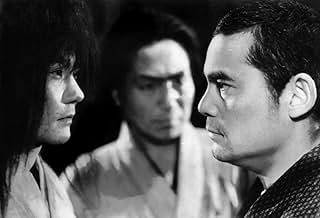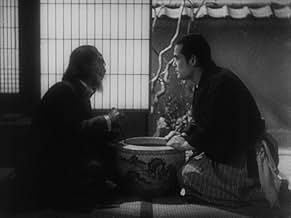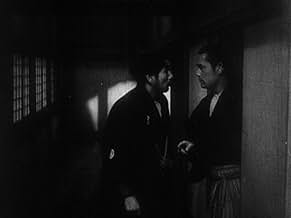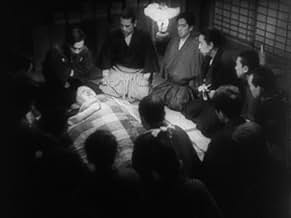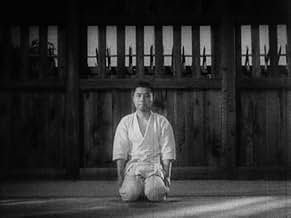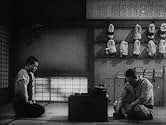Kô Ishida
- Daisuburo Hidarimonji
- (as Ko Ishida)
Osman Yusuf
- American Sailor
- (as Osman Yusef)
- Director
- Writers
- All cast & crew
- Production, box office & more at IMDbPro
Featured reviews
Though not impressed with the original Sanshiro Sugata I did consider it a noteworthy film in Japanese movie history and certainly had its charm.
The sequel see's our judo fighter hero presented with further foes he must vanquish and more moral dilemmas. Ontop of this he finds himself pressured into participating in an east vs west/boxing vs judo bout.
This sequel was heavily criticized and considered a propaganda film (Of which there were many around this time coming out of Japan). Truth be told I don't understand why or how this could be considered such, there was no military/political motivation to be found.
Inferior to the original? Yes, but not by much. The Sanshiro Sugata movies have their merits but don't deserve (In my opinion) the critical acclaim they recieved. I'm curious what happened with the sequels and quite look forward to finding out.
The Good:
Follows on from the original well
The Bad:
Looks dated even for its time
Things I Learnt From This Movie:
Susumu Fujita was reincarnated as Mark Dacascos
Fighting barefoot in the snow for real, there should be an oscar category for such feats!
The sequel see's our judo fighter hero presented with further foes he must vanquish and more moral dilemmas. Ontop of this he finds himself pressured into participating in an east vs west/boxing vs judo bout.
This sequel was heavily criticized and considered a propaganda film (Of which there were many around this time coming out of Japan). Truth be told I don't understand why or how this could be considered such, there was no military/political motivation to be found.
Inferior to the original? Yes, but not by much. The Sanshiro Sugata movies have their merits but don't deserve (In my opinion) the critical acclaim they recieved. I'm curious what happened with the sequels and quite look forward to finding out.
The Good:
Follows on from the original well
The Bad:
Looks dated even for its time
Things I Learnt From This Movie:
Susumu Fujita was reincarnated as Mark Dacascos
Fighting barefoot in the snow for real, there should be an oscar category for such feats!
I searched for this film for many years after having seen and loved the original. After living in Japan for a while I came across a Japanese language version.
This movie was a great disappointment to me and I'm sorry to say that Donald Ritchie's observation that Akira did not seem to take this project seriously seems to hold true. It has none of the visual or dramatic impact of the first Sanshiro film leaving only a standard Japanese propaganda film with little in the way of new scenarios,characterization or concepts.
Unfortunately, even for fans like myself of Kurosawa this film is hardly worth watching.
This movie was a great disappointment to me and I'm sorry to say that Donald Ritchie's observation that Akira did not seem to take this project seriously seems to hold true. It has none of the visual or dramatic impact of the first Sanshiro film leaving only a standard Japanese propaganda film with little in the way of new scenarios,characterization or concepts.
Unfortunately, even for fans like myself of Kurosawa this film is hardly worth watching.
I ended my recent review of "Sanshiro Sugata" by a sneaky remark. I alleged that the lead actor Susumu Fujita was no Toshiro Mifune... and I wish I could have found a more pleasant way to put it.
Now, let me reformulate. As true as it might be that Fujita doesn't have the same range, charisma or 'magnitude' than international icon Mifune, it is as unfair as comparing Harry Carey Jr. To John Wayne. And after that weird and rather corny opening, his appearance was quite a welcome sight. Indeed, something about the first minutes of the sequel of "Sanshiro Siguta" (which I prefer to refer to as "The Legend of the Great Judo") really set me off. The drunken Yankee sailor (played by Osman Yusuf!) kept blabbering some American slang with a rather convincing accent but the rickshaw was playing it it (no pun intended) as if he was playing in a Mac Senntt film.
Fujita's entrance changes the tone. He looks stern, menacing, and oddly intimidating. The confrontation did not leave much for suspense; it was obvious that for his opening fight scene would be an easy win. Still, whatever is wrong with the sequel has nothing to do with Fujita, who delivers a memorable performance as the young, idealistic and well-meaning martial arts student. It is a good thing because Siguta is in such a perpetual self-doubt that his quest could have taken a trilogy. I doubt it would have helped Kurosawa's career and I am sure he was more than glad to change this after the war. Therefore, at the end Siguta reaches his personal nirvana after Kurosawa stretched his arc as far as he could.
For the rest, it takes a while for the film to find its tone as it keeps being entangled in the necessity to make a point about the art of judo's superiority over boxing, the decadent export of US. Apparently Kurosawa was somewhat forced into making the film a propaganda by underlining without any attempt at subtitlity that boxing incarnates a failure of civilization that is so opposed to the quest of Judo... but for that, Americans are barely present and are replaced by a Japanese manager who's a caricatural sellout. While the film is by no means mediocre, it is not the master's finest hour and you can tell that if it wasn't for that propaganda subtext, it could have made for a better experience. It doesn't help that the image and sound quality (obviously not restored) make it difficult to appreciate.
Now the film is slightly better when it makes connections with the previous one and shows Sigita struggling to forgive himself for the death of Yono's father (played by Shimura in the first film) and when all of sudden, two strange long-haired characters who look like coming from a fantasy horror film and with expressionnist shadows decide to come to revenge their brothers, leading to a climax set in the snow-covered mountains. Iy is so magnificent you'd think it was borrowed from another film... and come way too late in the film.
Overall, it is a decent film but, the result is so beneath the standards of excellence of Kurosawa and of intelligence, that it will probably satisfy some history buffs looking for expressions of propaganda Japanese film and naturally the completists. Apart from that, it is a warmup before Toshiro Mifune who was certainly the muse Kurosawa needed (with Shimura being the touchstone)
Now, let me reformulate. As true as it might be that Fujita doesn't have the same range, charisma or 'magnitude' than international icon Mifune, it is as unfair as comparing Harry Carey Jr. To John Wayne. And after that weird and rather corny opening, his appearance was quite a welcome sight. Indeed, something about the first minutes of the sequel of "Sanshiro Siguta" (which I prefer to refer to as "The Legend of the Great Judo") really set me off. The drunken Yankee sailor (played by Osman Yusuf!) kept blabbering some American slang with a rather convincing accent but the rickshaw was playing it it (no pun intended) as if he was playing in a Mac Senntt film.
Fujita's entrance changes the tone. He looks stern, menacing, and oddly intimidating. The confrontation did not leave much for suspense; it was obvious that for his opening fight scene would be an easy win. Still, whatever is wrong with the sequel has nothing to do with Fujita, who delivers a memorable performance as the young, idealistic and well-meaning martial arts student. It is a good thing because Siguta is in such a perpetual self-doubt that his quest could have taken a trilogy. I doubt it would have helped Kurosawa's career and I am sure he was more than glad to change this after the war. Therefore, at the end Siguta reaches his personal nirvana after Kurosawa stretched his arc as far as he could.
For the rest, it takes a while for the film to find its tone as it keeps being entangled in the necessity to make a point about the art of judo's superiority over boxing, the decadent export of US. Apparently Kurosawa was somewhat forced into making the film a propaganda by underlining without any attempt at subtitlity that boxing incarnates a failure of civilization that is so opposed to the quest of Judo... but for that, Americans are barely present and are replaced by a Japanese manager who's a caricatural sellout. While the film is by no means mediocre, it is not the master's finest hour and you can tell that if it wasn't for that propaganda subtext, it could have made for a better experience. It doesn't help that the image and sound quality (obviously not restored) make it difficult to appreciate.
Now the film is slightly better when it makes connections with the previous one and shows Sigita struggling to forgive himself for the death of Yono's father (played by Shimura in the first film) and when all of sudden, two strange long-haired characters who look like coming from a fantasy horror film and with expressionnist shadows decide to come to revenge their brothers, leading to a climax set in the snow-covered mountains. Iy is so magnificent you'd think it was borrowed from another film... and come way too late in the film.
Overall, it is a decent film but, the result is so beneath the standards of excellence of Kurosawa and of intelligence, that it will probably satisfy some history buffs looking for expressions of propaganda Japanese film and naturally the completists. Apart from that, it is a warmup before Toshiro Mifune who was certainly the muse Kurosawa needed (with Shimura being the touchstone)
I have seen every Akira Kurosawa movie available on VHS or DVD and this is the first "bad" one among them. In fact, I will be so bold as to say I doubt he really directed it. His name is on the credits but I don't see a shred of him in the work. No environmentally framed shots, no contrasts of light and dark, no horizon dividing the frames. He must have done this one with a week of shooting time or a budget of 50 Yen. The comical fight between the Judo stylist and Karate stylist literally made me laugh out loud. It looked like parody. Nothing like the climatic fight in the first Sugata Sanshiro. Also the subtitles were apparently done by someone in China who could speak a little Japanese and a little English. They use the word "karate" for both karate and judo, and since the main conflict is between the two styles, you'd better pay attention to who's doing the the talking or you'll never follow the plot. The movie just about "braked" me.
Sugata and Yano have established the dominance of Judo over jujitsu by defeating all comers, but Sugata is not satisfied. Yes, he is the best Judo practitioner in the land, but he is plagued by his victories and is not sleeping.
Judo is also facing competition from boxing and karate. Yes, boxing has come to Japan with the occupation. The anti-American sentiment is strong in this film as the top boxer is a drunken sailor who pick on poor rickshaw drivers until Sugata manages to cool him off - laterally. They will meet again.
Sugata finally comes to terms with who he is and dispatches the boxer in the first round. Now, the karate thugs have been injuring many to get Sugata to fight.
The actual fight is a letdown. It is staged to look almost like those shadow puppets. The calm and cool Sugata is facing a grimacing overly loud competitor.
It should not be a surprise who wins, but there are more demons on the horizon. Five years after this film, I will have arrived. What will happen then? The only distraction was the poor quality of the film. One would hope that a better copy would have survived. Of course, we have to wait until the arrival of Toshiro Mifune before Akira Kurosawa perfects his Samurai films and becomes the great master that he was.
Judo is also facing competition from boxing and karate. Yes, boxing has come to Japan with the occupation. The anti-American sentiment is strong in this film as the top boxer is a drunken sailor who pick on poor rickshaw drivers until Sugata manages to cool him off - laterally. They will meet again.
Sugata finally comes to terms with who he is and dispatches the boxer in the first round. Now, the karate thugs have been injuring many to get Sugata to fight.
The actual fight is a letdown. It is staged to look almost like those shadow puppets. The calm and cool Sugata is facing a grimacing overly loud competitor.
It should not be a surprise who wins, but there are more demons on the horizon. Five years after this film, I will have arrived. What will happen then? The only distraction was the poor quality of the film. One would hope that a better copy would have survived. Of course, we have to wait until the arrival of Toshiro Mifune before Akira Kurosawa perfects his Samurai films and becomes the great master that he was.
Did you know
- TriviaThe final fight scene was filmed outdoors in real snow. Susumu Fujita, fighting barefoot, had to be carried to a bonfire between each shot as his feet would go numb.
- ConnectionsFollows La légende de judo (1943)
- How long is Sanshiro Sugata, Part Two?Powered by Alexa
Details
- Release date
- Country of origin
- Language
- Also known as
- La nouvelle légende du grand judo
- Filming locations
- Toho Studios, Tokyo, Japan(Studio)
- Production company
- See more company credits at IMDbPro
- Runtime
- 1h 23m(83 min)
- Color
- Sound mix
- Aspect ratio
- 1.37 : 1
Contribute to this page
Suggest an edit or add missing content

